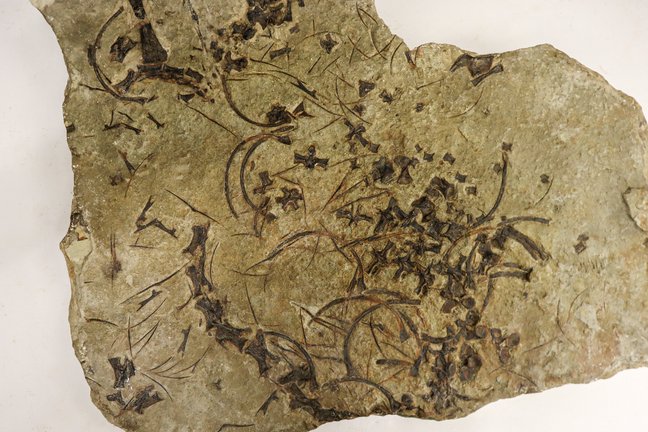Stuttgart, 15.03.2024. An international team of scientists led by Dr Stephan Spiekman, Dr Eudald Mujal and Prof. Dr Rainer Schoch, paleontologists at the State Museum of Natural History Stuttgart, has re-examined the fossil of the reptile Trachelosaurus fischeri, which was first described at the beginning of the 20th century. Comparisons with new fossil finds of a similar marine reptile from China show that Trachelosaurus fischeri is the world's oldest long-necked marine reptile. The scientists have published their research findings on the 247-million-year-old fossil from Sachsen-Anhalt, Gemany, in the Swiss Journal of Palaeontology.
Trachelosaurus fischeri was already discovered back in the 19th century in layers of Buntsandstein (Middle Triassic) in Bernburg an der Saale, Germany, and it was subsequently added to the collection of Martin Luther University Halle-Wittenberg. The specimen is currently on loan to the State Museum of Natural History Stuttgart, where it was re-examined by specialists. Trachelosaurus fischeri was first described in a publication in 1918, but controversy remained as to what kind of reptile this fossil actually represented. This is because Trachelosaurus fischeri has a unique anatomy, including an unusually large number of vertebrae, and because of the relatively poor preservation of the fossil: the skeleton is incomplete and its remains are scattered all over the rock in which it was preserved.
"Through research on Chinese fossils of the long-necked marine reptile Dinocephalosaurus, which I published with colleagues just a few weeks ago, we were able to solve the mystery of Trachelosaurus fischeri. The anatomy shows us that it is closely related to Dinocephalosaurus. Trachelosaurus fischeri is the first fossil of this reptile group to be found outside of China. It is also the oldest long-necked marine reptile known to date," says Dr Stephan Spiekman, an expert on this group of animals at the State Museum of Natural History Stuttgart.
After the great mass extinction at the Permian-Triassic boundary 252 million years ago, there was a very rapid diversification of new reptile species on both land and in the water at the beginning of the Triassic period. These included the first long-necked marine reptiles. How these complex evolutionary biological developments took place is an important subject of research. The scientists suspect that Trachelosaurus fischeri was washed into a shallow water area 247 million years ago, as footprints of land-dwelling animals are also preserved on the rock in which the fossil is preserved.
For the researchers, the find and its re-evaluation are another piece of the puzzle to better understand marine ecosystems at the beginning of the Triassic period. The history of the fossil shows the importance of historical museum and university collections for natural history research, emphasise the authors of the study. New discoveries from various parts of the world regularly enable scientists to reinterpret what was already discovered many years, sometimes even centuries, ago, and what is carefully being kept in museums.
For the editors
Original publication:
Stephan N. F. Spiekman, Martin D. Ezcurra, Adam Rytel, Wei Wang, Eudald Mujal, Michael Buchwitz and Rainer R. Schoch: A redescription of Trachelosaurus fischeri from the Buntsandstein (Middle Triassic) of Bernburg, Germany: the first European Dinocephalosaurus like marine reptile and its systematic implications for long necked early archosauromorphs. Swiss Journal of Palaeontology.
DOI: https://doi.org/10.1186/s13358-024-00309-6
Publication date: 15.03.2024
Image material:
Image 1: Fossil_Trachelosaurus fischeri_SMNS_L. Reinöhl.jpg
Description: The fossil of the long-necked marine reptile Trachelosaurus fischeri.
Copyright: SMNS, L. Reinöhl
Image 2: Schoch_Spiekman_Mujal_SMNS_L.Reinöhl.jpg
Description: Prof. Dr Rainer Schoch, Dr Stephan Spiekman, Dr Eudald Mujal in the marine reptile collection of the State Museum of Natural History Stuttgart with the fossil of Trachelosaurus fischeri. Trachelosaurus fischeri was borrowed from the collection of the Martin Luther University Halle-Wittenberg for research purposes.
Copyright: SMNS, L. Reinöhl
Please note that use of the image material is only permitted with a copyright notice. Thank you very much.
The State Museum of Natural History Stuttgart:
Innovative research and knowledge transfer in focus.
With its research collections, the "archives of diversity", the museum houses over 12 million objects. Its scientific activities focus on researching the evolution of life and analysing the biodiversity of different ecosystems. In two permanent exhibitions, changing special exhibitions, events and guided tours, the State Museum of Natural History Stuttgart conveys both basic natural history knowledge and current research findings to the general public in order to promote a lasting understanding of nature and its complex interrelationships.
Contact:
Dr Stephan Spiekman
State Museum of Natural History Stuttgart, Germany
Phone: +49/(0)711/89 36/170
E-mail: stephan.spiekman(at)smns-bw.de
Dr Stephan Spiekman is at your disposal for further information and interviews.
Press contact:
Meike Rech
State Museum of Natural History Stuttgart, Germany
Tel. ++49/(0)711/8936/107
E-mail: meike.rech(at)smns-bw.de
